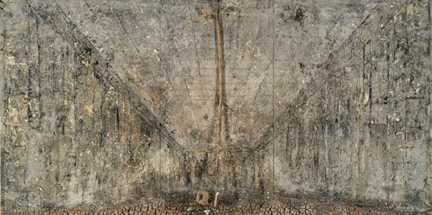
Oil, emulsion, acrylic paint, clay, ash, earth, and dried sunflower on canvas
149 5/8 x 299 1/4 inches
Image courtesy of the Modern Art Museum of Fort Worth
The day I first encountered Anselm Kiefer’s paintings, I was seven months pregnant with my first son. Because I am no longer that not-yet-mother, I can see her in my mind’s eye, wearing her mint green jacket, blond head tilted back, hand on her belly as she enters a gallery filled with massive, brooding landscapes. At first she doesn’t know where to look—all the canvasses are so arresting—and then one catches her eye and she drifts slowly over.
Anselm Kiefer was born in Germany in 1945, the year the Third Reich ended. He is nine years younger than my German father, who raced down to the basement shelter when his hometown was bombed by the Americans and emerged the next day to smashed streets and imminent surrender.
Kiefer’s paintings made windows of the museum walls, with dramatic views of a black, gold, battered-but-still-fertile earth. I remember the paintings as a collective, except for one giant gray canvas depicting a ceremonial hall. A sunflower hung upside down at its center, its blossom husk nearly touching the floor. The label read: Die Aschenblume. The Ash Flower. The hall was the Grand Mosaic Room in the former Third Reich Chancellery, painted and then smudged with ash.
As I stared into the gritty, cracked canvas, I felt a thrum of recognition. My father was a good man, raised by Mitläufer, Germans who went along with Naziism, reaping its benefits and later its consequences. My father witnessed his own father, a doctor, deployed to an army hospital in Weimar, then after the war, get stripped of his license to practice public medicine and sent to work on a logging crew. My father experienced his mother dying in the childbirth of his youngest brother in 1942, and lost all the fingers on his right hand in an accident in 1944. By the time Anselm Kiefer was born, my father was orphaned, permanently injured, and starving under the strict international aid laws of the reconstruction.
All my life I had weighed these facts against the Holocaust and come up empty.
I stared into Kiefer’s Ash Flower. The ruined interior, the dried flower-stalk hanging upside down—it was an arid scene, but it contained the residue of life and renewal.
“There is no history,” the artist said in a video outside the exhibition. He sat loosely before the camera, a shaved-headed, intense man with a quirk of humor about his mouth. His English was broken but emphatic. “[But] each human being tries to create a bigger context.” To create that context, you created an illusion that you stayed on the earth for a century and saw what unfolded. “This reassures you to find a sense in the world because there is no sense.”
Kiefer had borrowed his image from a Paul Celan poem, and now I would borrow it from him. I would seek my way by writing toward the Ash Flower and my own sense of it, my own meaning. The ash flower: the blossom of fire and dust over bombed Germany. The springtime end of the war, the Holocaust exposed, renewal and guilt and suffering spun together. The blighted innocence of children like Kiefer and my father.
My own son was born. I began writing a book. At first it was about my grandfather’s experiences at the Weimar hospital and his flight across war-torn Germany to reunite with his family. A year into the draft, my son fell acutely ill, and I realized the heart of the novel was elsewhere, mostly in the home, where the children were. It was watching a new mother try and fail to keep three boys safe and well as the Reich crumbled. Retreating armies and liberated concentration camps drifted offstage, and in their place rose intimate scenes of neighbors betraying neighbors, a baby struggling to walk in a cellar shelter.
The novel’s original title was The Ash Flower. I knew the title would change: I had entered my book through a doorway that Kiefer had made, but I would exit through my own. The travels of a novelist are always one way, and once-great vistas become postcards in a long, idiosyncratic journey. Yet Kiefer’s work will always possess, for me, a humbling and magnetic power. When I think back to the young woman I was, gazing at the upside-down sunflower, I realize how tall that bloom must have been, when it first grew upward from the earth. It would have towered over me.
Maria Hummel’s most recent contributions to NER include her poem, “The First Turn Might Be the Right One Home” in NER 34.1, and her story, “No Others Before Me” in NER 31.2. She is the author of Motherland (Counterpoint, 2014) and House and Fire, winner of the 2013 APR/Honickman Prize.
NER Digital is New England Review’s online project dedicated to original creative writing for the web. “Confluences” is a bi-weekly series in which we present a writer’s encounter with a work of art such as a book, play, poem, film, painting, sculpture, or building.